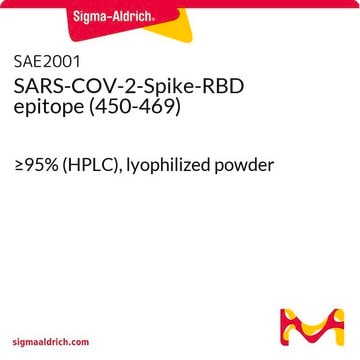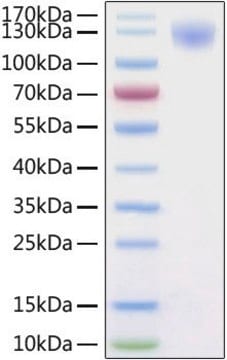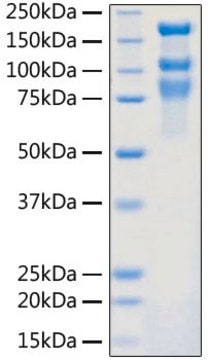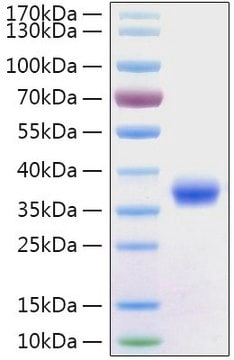SAE2000
SARS-COV-2-Spike-RBD epitope (370-394)
≥95% (HPLC), lyophilized powder
Synonym(s):
COVID-19 epitope, Immune response epitope, SARS-COV-2 Spike protein peptide
Sign Into View Organizational & Contract Pricing
All Photos(1)
About This Item
UNSPSC Code:
12352203
NACRES:
NA.41
Recommended Products
Quality Level
form
lyophilized powder
solid
species reactivity
viral
UniProt accession no.
storage temp.
−20°C
target post-translational modification
unmodified
Gene Information
SARS coronavirus ... S(43740568)
General description
Severe Acute Respiratory Syndrome Coronavirus 2 (SARS-CoV-2) or (2019-nCoV) is a novel coronavirus that emerged in December 2019 and since then has infected millions of people worldwide.1 The Spike protein (also known as S protein) is the most studied of the coronaviruses proteins, since it contains the Receptor-Binding-Domain (RBD) for the ligand on the host cell membrane (the ACE2 protein), and also has epitopes recognized by T and B cells
Specificity
SARS-COV-2-Spike-RBD epitope (370-394) is a synthetic peptide corresponding to the amino acid sequence of Spike RBD region (GeneID: QHD43416.1) in positions 370-394.Peptides derived from the SARS-COV-2-Spike-RBD protein can be recognized by anti-SARS-CoV-2-Spike protein antibodies.
Immunogen
S370-394: nsasfstfkcygvsptklndlcftn
Application
The peptide may be used in various immunochemical techniques including Immunoblotting and Elisa.
Biochem/physiol Actions
The Spike protein (also known as S protein) is a type I trimeric glycoprotein that is presented on the virion membrane, giving it the appearance of a crown. The protein has two subunits: S1, or bulb, that contains the RBD3-10; and S2, or stalk, responsible for the fusion of the virion with the host cell membrane. The main receptor for SARS-CoV and SARS-CoV-2 on the membrane of the target cells is the Angiotensin 2 Converting Enzyme (ACE2), a metallopeptidase present on the membrane of many cells, including type-I and -II pneumocytes, small intestine enterocytes, kidney proximal tubules cells, the endothelial cells of arteries and veins, and the arterial smooth muscle, among other tissues.15-18
Physical form
Supplied as a lyophilized powder.Purity: ≥95% (HPLC)
Storage and Stability
Store the product at −20 °C. After initial thawing, it is recommended to store the peptide in working aliquots at −20°C. Recommended thawing solution: Water.
Disclaimer
Unless otherwise stated in our catalog or other company documentation accompanying the product(s), our products are intended for research use only and are not to be used for any other purpose, which includes but is not limited to, unauthorized commercial uses, in vitro diagnostic uses, ex vivo or in vivo therapeutic uses or any type of consumption or application to humans or animals.Data presented is the available current product information and provided as-is. This product has not been tested or verified in any additional applications, sample types, including any clinical use. Experimental conditions must be empirically derived by the user. Our Antibody Guarantee only covers tested applications stated herein and conditions presented in our product information and is not extended to publications.
Storage Class Code
13 - Non Combustible Solids
WGK
WGK 3
Flash Point(F)
Not applicable
Flash Point(C)
Not applicable
Certificates of Analysis (COA)
Search for Certificates of Analysis (COA) by entering the products Lot/Batch Number. Lot and Batch Numbers can be found on a product’s label following the words ‘Lot’ or ‘Batch’.
Already Own This Product?
Find documentation for the products that you have recently purchased in the Document Library.
Mining of epitopes on spike protein of SARS-CoV-2 from COVID-19 patients.
Bao-Zhong Zhang et al.
Cell research, 30(8), 702-704 (2020-07-03)
To Sing Fung et al.
Annual review of microbiology, 73, 529-557 (2019-06-22)
Human coronavirus (HCoV) infection causes respiratory diseases with mild to severe outcomes. In the last 15 years, we have witnessed the emergence of two zoonotic, highly pathogenic HCoVs: severe acute respiratory syndrome coronavirus (SARS-CoV) and Middle East respiratory syndrome coronavirus
Daniel Wrapp et al.
Science (New York, N.Y.), 367(6483), 1260-1263 (2020-02-23)
The outbreak of a novel coronavirus (2019-nCoV) represents a pandemic threat that has been declared a public health emergency of international concern. The CoV spike (S) glycoprotein is a key target for vaccines, therapeutic antibodies, and diagnostics. To facilitate medical
Jian Shang et al.
PLoS pathogens, 16(3), e1008392-e1008392 (2020-03-10)
Coronaviruses recognize a variety of receptors using different domains of their envelope-anchored spike protein. How these diverse receptor recognition patterns affect viral entry is unknown. Mouse hepatitis coronavirus (MHV) is the only known coronavirus that uses the N-terminal domain (NTD)
Jian Shang et al.
Nature, 581(7807), 221-224 (2020-04-01)
A novel severe acute respiratory syndrome (SARS)-like coronavirus (SARS-CoV-2) recently emerged and is rapidly spreading in humans, causing COVID-191,2. A key to tackling this pandemic is to understand the receptor recognition mechanism of the virus, which regulates its infectivity, pathogenesis
Our team of scientists has experience in all areas of research including Life Science, Material Science, Chemical Synthesis, Chromatography, Analytical and many others.
Contact Technical Service








